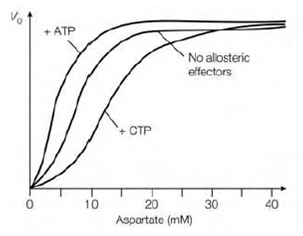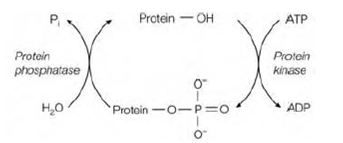Reversible covalent modification
Reversible covalent modification is the making and breaking of a covalent bond among a nonprotein group and an enzyme molecule. While a range of nonprotein groups may be reversibly attached to enzymes that affect their activity, the mainly general modification is the removal and addition of a phosphate group phosphorylation and dephosphorylation, respectively. The Phosphorylation is catalyzed through protein kinases, frequently using ATP as the

Figure: Plot of initial velocity (V0 ) against substrate concentration for the allosteric enzyme aspartate transcarbamoylase.

Figure: The reversible phosphorylation and dephosphorylation of an enzyme.
phosphate donor and dephosphorylation is catalyzed through protein phosphatases in above figure. The removal and addition of the phosphate group causes modification in the tertiary structure of the enzyme which alter its catalytic activity. One class of the protein kinases transfers the phosphate specifically on to the hydroxyl group of Thr or Ser residues on the goal enzyme serine or threonine protein kinases, typified through 3′,5′-cyclic adenosine monophosphate (cAMP)-dependent protein kinase, although a second class transfers the phosphate on to the hydroxyl group of Tyr residues tyrosine kinases. The Protein phosphatases catalyze the hydrolysis of phosphate groups from proteins to regenerate not modify hydroxyl group of the amino acid and release Pi which is shown in figure.
A phosphorylated enzyme may be either less or more active than its dephosphorylated form.Therefore phosphorylation or dephosphorylation may be used as a rapid reversible that is switched to turn a metabolic pathway on or off according to the requirement of the cell. For instance glycogen phosphorylase an enzyme included in glycogen breakdown is active in its phosphorylated form and glycogen synthase, included in glycogen synthesis is much active in its unphosphorylated form.
Other kinds of reversible covalent modification which are used to regulate the activity of certain enzymes involves adenylylation the transfer of adenylate from ATP and ADP-ribosylation the transfer of an ADP (adenosine diphosphate)-ribosyl moiety from NAD.